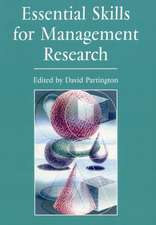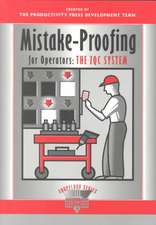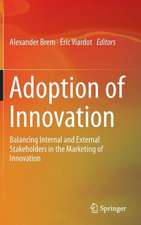Navigating Intellectual Capital After the Financial Crisis
Autor Carol Yeh-Yun Lin, Leif Edvinsson, Jeffrey Chen, Tord Bedingen Limba Engleză Hardback – 25 iul 2014
Examining the financial crisis from the viewpoint of intangible assets provides a different perspective from traditional economic approaches. National Intellectual Capital (NIC), comprised mainly of human capital, market capital, process capital, renewal capital and financial capital, is a valuable intangible asset and a key source of national competitive advantage in today’s knowledge economy. The authors—pioneers in the field—present extensive data and a rigorous conceptual framework to analyze the connections between the global financial crisis and NIC development. Covering the period from 2005 to 2010 across 48 countries, the authors establish a positive correlation between NIC and GDP per capita and consider the impact of NIC investment for short-term recovery and long-term risk control and strategy formulation.
This book summarizes and synthesizes the data presented in a series of eleven SpringerBriefs volumes on “National Intellectual Capital and the Financial Crisis,” concerning the co-developments between NIC and GDP growth and describes the internal and external factors that influenced the relative success or failure of national strategies in weathering the crisis. The authors go on to explore the impacts of various policy reforms, including stimulus packages and consolidations employed around the world, with particular respect to the factors enhancing or impeding short-term recovery versus long-term growth. Finally, they propose a new model of “sustainable nationalintellectual capital” and challenge readers to consider how to pass on a healthy globe and harmonious society to the next generation.
| Toate formatele și edițiile | Preț | Express |
|---|---|---|
| Paperback (1) | 557.59 lei 39-44 zile | |
| Springer – 3 sep 2016 | 557.59 lei 39-44 zile | |
| Hardback (1) | 644.82 lei 6-8 săpt. | |
| Springer – 25 iul 2014 | 644.82 lei 6-8 săpt. |
Preț: 644.82 lei
Preț vechi: 758.60 lei
-15% Nou
Puncte Express: 967
Preț estimativ în valută:
123.39€ • 131.94$ • 102.88£
123.39€ • 131.94$ • 102.88£
Carte tipărită la comandă
Livrare economică 17 aprilie-01 mai
Preluare comenzi: 021 569.72.76
Specificații
ISBN-13: 9781493912940
ISBN-10: 1493912941
Pagini: 200
Ilustrații: XXVIII, 229 p. 107 illus. in color.
Dimensiuni: 155 x 235 x 17 mm
Greutate: 0.54 kg
Ediția:2014
Editura: Springer
Colecția Springer
Locul publicării:New York, NY, United States
ISBN-10: 1493912941
Pagini: 200
Ilustrații: XXVIII, 229 p. 107 illus. in color.
Dimensiuni: 155 x 235 x 17 mm
Greutate: 0.54 kg
Ediția:2014
Editura: Springer
Colecția Springer
Locul publicării:New York, NY, United States
Public țintă
ResearchCuprins
Chapter 1 Introduction.- Chapter 2 Macroeconomic Development Comparisons of the 48 Countries.- Chapter 3 Insights from NIC and GDP Co-development.- Chapter 4 Internal and External Influence.- Chapter 5 Types of Stimulus Packages and Consolidation.- Chapter 6 Enhancing and impeding policies before and during the crisis.- Chapter 7 Structural Reforms After the Financial Crisis.- Chapter 8 Navigating Intellectual Capital after the Financial Crisis.
Textul de pe ultima copertă
In the first decade of the twenty-first century, the biggest event of worldwide proportion was the 2008 global financial crisis, which was caused primarily by ineffective governance, failed surveillance systems, and implementation flaws. While fiscal and monetary policies succeeded in pulling many countries out of a financial freefall, most economies have performed beneath pre-recession levels as governments continued to struggle with their finances.
Examining the financial crisis from the viewpoint of intangible assets provides a different perspective from traditional economic approaches. National Intellectual Capital (NIC), comprised mainly of human capital, market capital, process capital, renewal capital, and financial capital, is a valuable intangible asset and a key source of national competitive advantage in today’s knowledge economy. The authors—pioneers in the field—present extensive data and a rigorous conceptual framework to analyze the connections between the global financial crisis and NIC development. Covering the period from 2005 to 2010 across 48 countries, the authors establish a positive correlation between NIC and GDP per capita and consider the impact of NIC investment for short-term recovery and long-term risk control and strategy formulation.
This book summarizes and synthesizes the data presented in a series of eleven SpringerBriefs volumes on “National Intellectual Capital and the Financial Crisis,” concerning the co-developments between NIC and GDP growth, and describes the internal and external factors that influenced the relative success or failure of national strategies in weathering the crisis. The authors go on to explore the impacts of various policy reforms, including stimulus packages and consolidations employed around the world, with particular respect to the factors enhancing or impeding short-term recovery versus long-term growth. Finally, they propose a new model of “sustainablenational intellectual capital” and challenge readers to consider how to pass on a healthy globe and harmonious society to the next generation.
Examining the financial crisis from the viewpoint of intangible assets provides a different perspective from traditional economic approaches. National Intellectual Capital (NIC), comprised mainly of human capital, market capital, process capital, renewal capital, and financial capital, is a valuable intangible asset and a key source of national competitive advantage in today’s knowledge economy. The authors—pioneers in the field—present extensive data and a rigorous conceptual framework to analyze the connections between the global financial crisis and NIC development. Covering the period from 2005 to 2010 across 48 countries, the authors establish a positive correlation between NIC and GDP per capita and consider the impact of NIC investment for short-term recovery and long-term risk control and strategy formulation.
This book summarizes and synthesizes the data presented in a series of eleven SpringerBriefs volumes on “National Intellectual Capital and the Financial Crisis,” concerning the co-developments between NIC and GDP growth, and describes the internal and external factors that influenced the relative success or failure of national strategies in weathering the crisis. The authors go on to explore the impacts of various policy reforms, including stimulus packages and consolidations employed around the world, with particular respect to the factors enhancing or impeding short-term recovery versus long-term growth. Finally, they propose a new model of “sustainablenational intellectual capital” and challenge readers to consider how to pass on a healthy globe and harmonious society to the next generation.
Caracteristici
Analyzes data across 48 countries to demonstrate a strong correlation between national intellectual capital investment and economic growth Addresses the factors leading to the global financial crisis of 2008 and the relative success or failure of strategies employed to stimulate recovery Considers policy options for long-term growth Features forewords by leading proponents of sustainable development
















